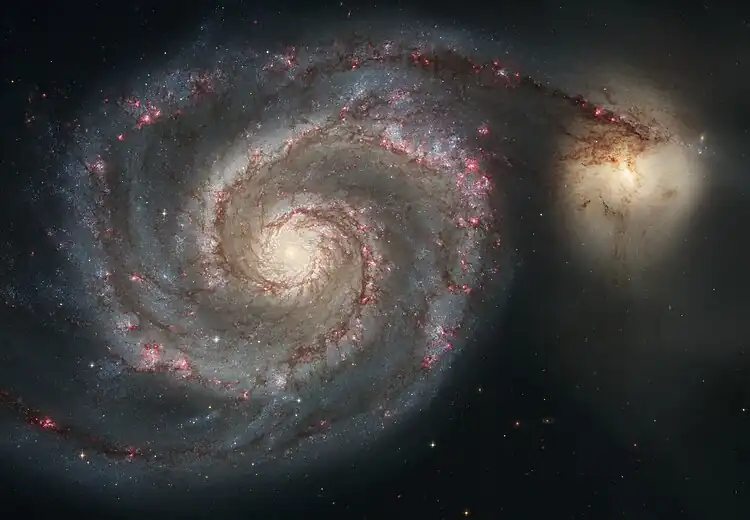| |||
|---|---|---|---|
|
| 1773 in science |
|---|
| Fields |
| Technology |
| Social sciences |
|
| Paleontology |
| Extraterrestrial environment |
| Terrestrial environment |
| Other/related |
The year 1773 in science and technology involved some significant events.
Astronomy

Whirlpool Galaxy
- October 13 – French astronomer Charles Messier discovers the Whirlpool Galaxy (pictured), an interacting, grand design spiral galaxy located at a distance of approximately 23 million light-years in the constellation Canes Venatici.
- Lagrange presents his work on the secular equation of the Moon to the Académie française, introducing the idea of the potential of a body. He also publishes on the attraction of ellipsoids.
Chemistry
- Hilaire Rouelle discovers urea.
- Carl Wilhelm Scheele and Joseph Priestley independently isolate oxygen, called by Priestley "dephlogisticated air" and Scheele "fire air".[1][2][3]
- Antoine Baumé publishes his textbook Chymie expérimentale et raisonnée in Paris.
Exploration
- January 17 – English Captain James Cook becomes the first European explorer to cross the Antarctic Circle.
- Spring – English Captain Tobias Furneaux explores the coast of Van Diemen's Land.
- June 4–September 30 – British Royal Navy Phipps expedition towards the North Pole, which produces the first scientific description of the polar bear and the ivory gull.[4]
Linguistics
- Scottish judge James Burnett, Lord Monboddo, begins publication of Of the Origin and Progress of Language, a contribution to evolutionary ideas of the Enlightenment.
Mathematics
- Lagrange considers a functional determinant of order 3, a special case of a Jacobian. He also proves the expression for the volume of a tetrahedron with one of the vertices at the origin as one sixth of the absolute value of the determinant formed by the coordinates of the other three vertices.
Medicine
- October 12 – North America's first insane asylum opens for 'Persons of Insane and Disordered Minds' in Williamsburg, Virginia.
- Medical Society of London founded by John Coakley Lettsom.
- Louis-Bernard Guyton de Morveau proposes the use of "muriatic acid gas" (hydrogen chloride) for fumigation of buildings.
Technology
- David Hartley patents a method of fireproofing construction for buildings and ships in Britain.
Institutions
- Istanbul Technical University is established (under the original name of Royal School of Naval Engineering) as the world's first comprehensive institution of higher learning dedicated to engineering education.
Awards
- Copley Medal: John Walsh[5]
- John Harrison receives the Longitude prize for his invention of the marine chronometer.[6]
Births
- January 29 – Friedrich Mohs, German mineralogist (died 1839)
- February 24 - Jean Boniface Textoris, French military surgeon (died 1828)[7]
- April 9 – Marie Boivin, French midwife, inventor and obstetrics writer (died 1841)
- May 19 – Arthur Aikin, English chemist and mineralogist (died 1854)
- June 13 – Thomas Young, English physicist (died 1829)
- June 29 (bapt.) – John Bostock, English physician and geologist (died 1846)
- July 23 – Thomas Brisbane, Scottish astronomer and Governor of New South Wales (died 1860)
- August 23 – Abraham Colles, Anglo-Irish surgeon (died 1843)
- October 28 – Simon Goodrich, English mechanical engineer (died 1847)
- December 21 – Robert Brown, Scottish botanist (died 1858)
- December 27 – George Cayley, English pioneer of heavier-than-air flight (died 1857)
Deaths
- July 16 – Nils Rosén von Rosenstein, Swedish pediatrician (born 1706)
- July 23 – George Edwards, English naturalist (born 1693)
References
- ↑ "Joseph Priestley". Science History Institute. Retrieved 21 March 2018.
- ↑ Bowden, Mary Ellen (1997). "Joseph Priestley". Chemical achievers : the human face of the chemical sciences. Philadelphia, PA: Chemical Heritage Foundation. pp. 5-7. ISBN 9780941901123.
- ↑ "Carl Wilhelm Scheele". History of Gas Chemistry. Center for Microscale Gas Chemistry, Creighton University. 2005-09-11. Retrieved 2007-02-23.
- ↑ Savours, Ann (1984). ""A Very Interesting Point in Geography": The 1773 Phipps Expedition towards the North Pole". Arctic. 37 (4): 402–428. doi:10.14430/arctic2224. ISSN 0004-0843. JSTOR 40510304.
- ↑ "Copley Medal | British scientific award". Encyclopedia Britannica. Retrieved 21 July 2020.
- ↑ "Icons, a portrait of England 1750-1800". Archived from the original on 17 August 2007. Retrieved 2007-08-25.
- ↑ "Notice no. LH//2582/41". Base Léonore (in French).
This article is issued from Wikipedia. The text is licensed under Creative Commons - Attribution - Sharealike. Additional terms may apply for the media files.